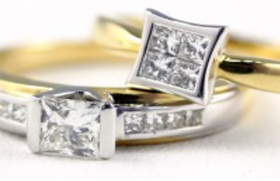De Beers Diamonds - Diamonds are forever

About Diamonds - What they are and how they formed
The name "diamond" comes from the Greek "adamas," meaning unconquerable/indestructible. Diamonds are made of pure carbon and diamonds are also the hardest natural substance known to man. Hence why diamonds are forever!
Diamonds are formed deep in the Earth around 120 kms deep, when if the conditions were right some 45 million to 2 billion years ago, extreme heat and pressure caused the carbon atoms to crystallize forming diamonds. Diamonds get to the surface with the help of volcanic eruptions. So who said that volcanic eruptions are all bad?
The four most popular factors used to measure diamond quality are cut, color, carat and clarity. De Beers introduced this set of criteria in 1939 in order to provide with a reference for evaluating diamonds. Nature dictates the characteristics of color, clarity and carat, while cut is directly influenced by humans. Although the 4Cs provide scientific guidelines for evaluating diamond quality, they do not necessarily measure diamond beauty.
Cut: Refers to the angles and proportions of a diamond.
Cut refers to the angles and proportions a skilled craftsman creates in transforming a rough diamond into a polished diamond.
A well-cut diamond will reflect light internally from one mirror-like facet to another, dispersing it through the top of the stone. Cuts that are too deep or too shallow lose or leak light through the side or bottom, affecting the diamond's brilliance.
Cut is the only one of the 4Cs that is influenced by the human hand. The rest (color, clarity, carat) are created naturally as diamonds form in the earth. Diamond cutting requires great skill and training. The cutter must polish tiny surfaces known as facets onto the rough diamond. This process is what creates the facets known as the crown, culet, table, girdle and pavilion of the diamond. The facets, when arranged in precise proportions, will maximize the fire life and brilliance of a diamond. To cut a diamond perfectly, a craftsman will often need to cut away more than 50% of the rough diamond.
Cut also refers to the shape of a diamond: round, emerald, heart, marquise or pear for example. A round diamond is the most brilliant of diamond shapes. Its symmetrical outline allows it to reflect nearly all of the light that enters the diamond.
Cutting style is categorized into three basic types: step-cut, brilliant-cut and mixed-cut. The difference among these three types is the facets of each style. Brilliant-cuts are scientifically found to reflect the most light. Step-cuts have rows of facets that resemble the steps of a staircase. The emerald and baguette are examples of this cutting style. Mixed-cuts have both step and brilliant-cut facets. One of the most popular types of mixed-cuts is the Princess.
Color: Refers to the degree to which a diamond is colorless.
Most diamonds appear icy white, but many have tiny hints of color. Diamonds are graded on a color scale established by the Gemological Institute of America (GIA), ranging from D (colorless) to Z.
Colorless diamonds are extremely rare, and therefore very valuable. But there are no hard and fast rules for what color makes a diamond beautiful. Diamonds are also sometimes found in pink, blue, green, yellow, brown, orange and very rarely, red. These diamonds, called 'fancies' are incredibly rare and valuable. These 'fancy' colors extend beyond the GIA color grading system.
Clarity: Refers to the presence of inclusions in a diamond.
Diamonds, like people, have natural blemishes in their make-up. These tiny faults, or inclusions are formed by minerals or fractures while the diamond is forming in the earth. When light enters a diamond, it is reflected and refracted out. If there is anything disrupting the flow of light in the diamond, such as an inclusion, a proportion of the light reflected will be lost. Most inclusions are not visible to the naked eye unless magnified.
Inclusions are ranked on a scale of perfection, or clarity, which ranges from FL (No visible characteristics under magnification) to I (Characteristics visible with the naked eye). This grading method rates diamonds on the size, nature and positioning of the birthmarks and requires an expert eye to assess.
To view inclusions, trained gemologists use a magnifying loupe. This tool allows our experts to see a diamond at 10x its actual size. Even with a loupe, the birthmarks in the VVS (Very, Very Slightly Included) to VS (Very Slightly Included) range can be very difficult to find. It is only when a diamond is graded 'I' that it is possible to see the birthmarks with the naked eye. What's the difference between VVS1 and VVS2 or SI1 and SI2? The numbers represent levels within each grade. The 1s will be cleaner (have fewer or smaller inclusions) than the 2s. This allows for more precise grading categories.
As with real birthmarks, inclusions appear as different shapes, such as crystals, clouds or feathers. These idiosyncrasies often add to the overall character of the diamond. The majority of these natural birthmarks are invisible to the naked eye, yet they affect the way light is reflected and refracted within the stone. Diamonds that have no inclusions under magnification are extremely rare and are rated FL for flawless.
The position of inclusions can affect the value of a diamond. You may not notice a significant difference between an SI 1 and a SI 2. However, you should consider the number, size, brightness, nature and position of the inclusions. Some inclusions can be hidden by a mounting, thus having little effect on the beauty of a diamond. An inclusion in the middle or top of a diamond, however, could impact the dispersion of light, sometimes making the diamond less brilliant.
Carat: Refers to the weight of a diamond.
Carat is often confused with size even though it is actually a measure of weight. The cut of a diamond can make it appear much larger or smaller than its actual weight.
High carat diamonds often appear to be brighter or more brilliant than their lower carat siblings due to the prism effect of light traveling over larger distances. However, carat is merely one of the factors to take into consideration when appraising the quality of the stone.
One carat (not to be confused with Karat-the measure of purity of gold) is the equivalent of 200 milligrams. One carat can also be divided into 100 "points." A .75 carat diamond is the same as a 75-points or a 3/4 carat diamond. The term carat is a derivative of the word carob. Carob seeds, which are surprisingly uniform in weight, were used as a reference for diamond weight in ancient civilizations. One carob seed equaled one carat.
It is often assumed that a 1-carat diamond costs exactly twice the price of a 1/2-carat diamond. This is not the case. Since larger diamonds are found less frequently in nature, a 1-carat diamond will cost much more than twice as much as a 1/2-carat diamond, assuming color, clarity and cut remain constant.
Diamonds Beauty
While high marks in the 4Cs are important to diamond quality, they are an insufficient measure of diamond beauty. A beautiful diamond is one that successfully maximizes the following beauty factors:
Brilliance - The total amount of white light, both external and internal, returned from the diamond to the eye of the observer.
Scintillation - Reflections and flashes of white light from the diamond's surface as the diamond, observer or light source moves.
Dispersion - The dispersion of white light into its component spectral colors.
Light Return Geometry - The "kaleidoscope" effect or spatial pattern of the diamond, which is pleasing to the eye due to degrees of symmetry.
Perceived Symmetry - The symmetry as seen by the eye, whereby all facets are well proportioned.
Color, clarity, fluorescence, polished girdle and the rough material from which the stone was cut, symmetry, the smoothness of the finish on each facet and the crispness of the ribs between facets all combine to influence diamond beauty.
And you wonder why diamonds are a girls best friend!
Source: http://www.debeers.com/
Also read related Diamond articles here:
Diamond Rings
Diamond Cuts
MORE



